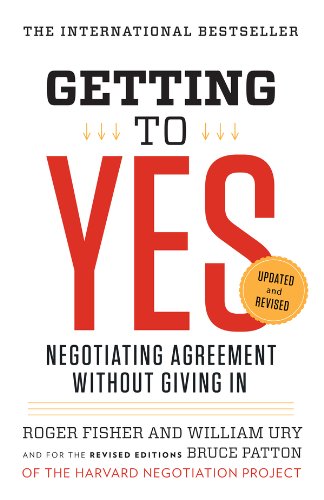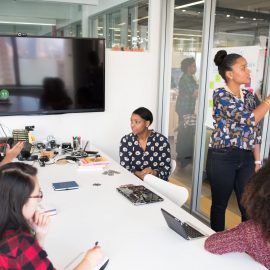

This article is an excerpt from the Shortform summary of "Getting to Yes" by Roger Fisher and William Ury. Shortform has the world's best summaries of books you should be reading.
Like this article? Sign up for a free trial here .
Negotiations at work are becoming more and more common, no matter what your role at your organization. We all need to learn to negotiate. What practicalities should you take into consideration when learning how to negotiate?
We’ll cover all the basics of how to negotiate: where to meet, how to communicate, which protocols to be aware of, and how to prepare.
The Logistics of Negotiation
Informal negotiations with family and friends about such things as where to eat or spend a vacation tend to be impromptu. However, formal negotiations between companies and employees, or involving governments, and other entities require planning. Here are some logistics and procedural considerations for understanding how to negotiate.
How to Negotiate: Where to Meet
Deciding where to meet for negotiations will depend on both needs and circumstances. Think about where the parties would be most comfortable and productive.
- Seclusion may be important if there’s a significant chance of interruptions and distractions.
- If the other side’s chief negotiator relies heavily on support staff and documentation, you may want to meet in his or her offices. Meeting in the other side’s offices also gives you the option of walking away if necessary.
- If there are equipment needs such as a whiteboard or computer projection screen, you’ll need a facility that accommodates them.
Although we don’t always give it much thought, the meeting place is an important consideration when figuring out how to negotiate.
How to Negotiate: Communication
Challenging conversations, especially those involving emotions or relationship issues, typically are best handled face to face. Electronic communication, which has become integral in our personal and work lives, can be useful as an adjunct in negotiations. But it has potential drawbacks as well as positives such as convenience. Carefully consider the pluses and minuses of various methods, including phone, email, text messages, and video chat applications.
Among the potential advantages:
- Many people are more comfortable asking tough questions on the phone than face-to-face.
- People pay closer attention to content when they don’t have visual or audio cues, such as tone of voice or facial expressions. Objections may have more impact when delivered in writing via email.
- Email allows time for reflection and research before answering.
- Emails and texts before the start of negotiations can create a personal connection before getting into substance. The connection may help promote cooperation and increase the chance of agreement.
However, beware of the potential drawbacks of non-face-to-face communication:
- Results can vary depending on the method of communication. One study showed written interactions can lead to impasses.
- There’s a greater potential for misunderstanding or lying.
- Lack of visual cues can make messages more difficult to interpret and decrease our empathy.
To prevent problems with non-face-to-face communication, this is how to negotiate:
- Try to have an initial meeting in person or by phone, as well as periodic check-ins in-person or by phone.
- Reread your messages several times before sending them; make the context and your reasoning extra-apparent, look for ambiguities, and ask yourself how it could be read differently from what you mean.
- If you can’t have a difficult conversation face to face, try to do it by phone or video chat.
How to Negotiate: Protocol and Strategy
There are numerous considerations involving protocol and strategy. People often ask, Who should make the first offer, and how high should it be? This is how to negotiate:
Wait to give the first offer: Making an offer too soon can make the other side feel rushed or pressured. It’s better to start by examining interests, options, and standards first. Once both sides have a handle on the problem, an offer that accommodates all interests will come across as constructive. In any case, in the early stages, you could try to introduce an objective or standard favorable to you. Ultimately, if both sides are well prepared for negotiation, it doesn’t make much difference who makes the first offer.
Deciding how high to start: In cases involving a buyer and seller, people are used to judging success by how far the other person retreats from their original position. The buyer’s goal is paying less than the original asking price. In traditional bargaining, if you’re selling, you start with the highest number you can ask for without looking unreasonable. In a principled negotiation, however, start with the highest figure that a neutral person would see as fair. And before making the offer, explain your rationale. You don’t want to be too firm initially because if you move later you may lose credibility. Alternatively, you could point out what people are paying for comparable items, thereby suggesting a standard without committing to that number.
How to Negotiate: Preparation
Thinking about the first offer at the outset gets the cart before the horse. Preparation is the initial step. Your strategy will grow naturally from your preparation. Since you won’t know what the other side’s strategy is going to be, it’s best to focus on preparation initially and decide your direction later.
Here’s how to prepare and move through the negotiation process (rather than simply starting off by considering how high an offer to make):
- Think about the end: Before starting to negotiate, think about what a good agreement would look like. To get there, what issues would have to be resolved? What kind of agreement could both sides justify to their constituents? Envisioning the end result will help you stay on track.
- Draft a framework agreement. Outline a potential agreement with spaces for each item to be resolved. It can serve as an agenda, help keep discussions focused, and ensure important issues are addressed.
- Don’t rush toward commitment. As you work through each issue, including options and standards, aim for a proposal that reflects all points made and meets each side’s interests on that issue. If you can’t get consensus on an issue, attempt to narrow the options and move on. Commitments should be deemed tentative at this point to encourage brainstorming. Expect to go through the issues several times, while making gradual forward progress.
- Pursue your interests persistently, but don’t lock into a specific solution (which would be positional). Explain your interests and reasoning, and have the other side explain theirs. Clarify points of agreement and disagreement. Resolve conflicting interests with independent standards.
- Make an offer. After you’ve explored one or more issues, make an offer. It should grow from the discussions so far rather than being a surprise, and should address the interests of both sides. If there are still outstanding issues, agree on fair procedures for resolving them (for instance, splitting the difference).
- Make a final gesture. When an agreement is near, consider giving the other side something they want that’s within the logic of the agreement. This may relieve last-minute doubts and seal the deal. If the other side leaves negotiations on a positive note, it will improve implementation and enhance the relationship.
———End of Preview———

Like what you just read? Read the rest of the world's best summary of "Getting to Yes" at Shortform . Learn the book's critical concepts in 20 minutes or less .
Here's what you'll find in our full Getting to yes summary :
- Why the standard way of negotiating is completely wrong
- How to find outcomes that are wins for both sides
- How to protect yourself against aggressive negotiators






